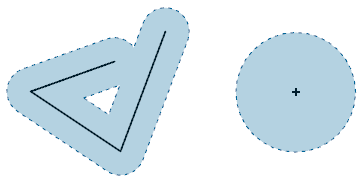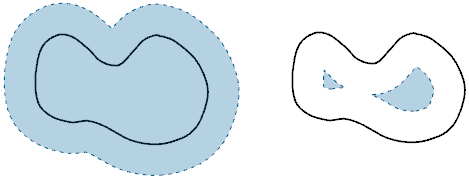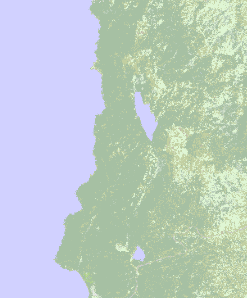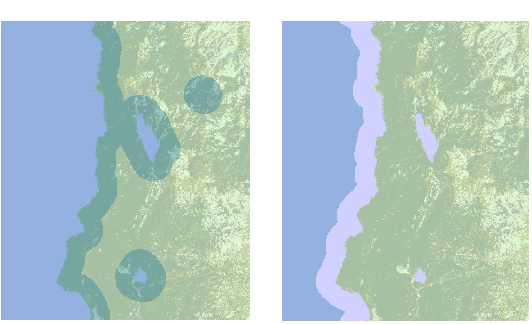BufferZoneOperator Class
Generates 2-dimensional buffer zones around vector and raster features.
NuGet/Assembly: Carmenta.Engine.5.17.0.nupkg (in the CEOperators assembly)
Syntax
public class BufferZoneOperator : UnaryOperatorRemarks
There is a sample map configuration buffer_zone_operator.px that demonstrates how a BufferZoneOperator can be used to generate buffer zones around points, lines, polygons and themes of a thematic raster.
This operator generates 2-dimensional buffer zones around vector and raster features. A buffer zone around a feature is defined as the union of circular areas with a specified Radius, such that every point in the feature is the center of one circular area. So the buffer zone for a point becomes a circle, and the buffer zone for a straight line becomes a hot-dog shaped polygon.
 |
Just setting the Radius is not enough. You must also set the Margin to be larger than any possible value of Radius.
For input features that are points, lines or polygons, the output features will be polygons. For an input polygon, it makes sense to use a negative radius, which would shrink the polygon instead of expanding it.
 |
To make a buffer zone for a thematic (discrete) raster, the operator uses the RasterValue property: the raster area filled with that value shall be buffered. For example, in the buffer_zone_operator.px sample configuration, the RasterValue is 11, which is the code for water in a terrain type raster. The output raster will have the same resolution as the original one, but will be a one-bit raster, in which raster cells containing 1 represent the buffer zone, and cells containing 0 represent everything else; the undefined value will be 0.
For raster input, too, it makes sense to use a negative Radius to shrink the area of interest.
 |
 |
The methods LineGeometry.BufferZone and PolygonGeometry.BufferZone are similar to this operator, but like all Geometry methods, they treat the coordinates as if they were expressed in a plane Cartesian coordinate system with an unspecified length unit, and this doesn't work well if the coordinates were really LongLat, for example. The BufferZoneOperator, on the other hand, knows about LongLat and map projections and can automatically reproject input features to a more suitable CRS before calculating the buffer zones. So, the output features from the operator can be expressed in a different CRS than the input features. However, due to the inevitable distortions when the round earth is mapped to a projected plane, the buffer zone calculations will be less accurate for larger features.
Inheritance Hierarchy
System.Object
EngineObject
Operator
UnaryOperator
BufferZoneOperator
Platforms
Windows, Linux, Android
BufferZoneOperator Members
The BufferZoneOperator type has the following members.
Constructors
| Name | Description |
|---|---|
| BufferZoneOperator | Initializes a new instance of the BufferZoneOperator class. |
Properties
| Name | Description |
|---|---|
| ArcAccuracy | Gets or sets a value specifying the accuracy of generated arcs. |
| Description | Gets or sets a short description of the operator. Inherited from Operator |
| DisplayName | Gets or sets a display name for the operator. Inherited from Operator |
| Input | Gets or sets the input operator, from which this operator reads features. Inherited from UnaryOperator |
| IsDisposed | Gets a value that tells whether the current BufferZoneOperator has been disposed. Inherited from EngineObject |
| IsoMetadataDocument | Gets or sets the path to an ISO 19139 metadata document for the operator. Inherited from Operator |
| Margin | Gets or sets a margin added to the view area when requesting data from the input operator. |
| Name | Gets or sets the name of the operator. Inherited from Operator |
| NativeHandle | Gets the native Carmenta Engine kernel object the current BufferZoneOperator represents. Inherited from EngineObject |
| Radius | Gets or sets the radius of the buffer zone. |
| RadiusUnit | Gets or sets the length unit that Radius is specified in. |
| RasterValue | Gets or sets the raster category that the buffer zone should be generated around. |
| IUserProperties.UserProperties | Gets the AttributeSet that contains the user properties. Inherited from IUserProperties |
Methods
| Name | Description |
|---|---|
| Clone | Creates a copy of an object. Inherited from EngineObject |
| Dispose | Releases the reference to the native Carmenta Engine kernel instance the EngineObject represents. Inherited from EngineObject |
| Equals | Determines whether this instance is equal to another. Inherited from EngineObject |
| FindChildObject | Overloaded. Finds the child object with the specified name. Inherited from Operator |
| FlushCache | Removes the objects that have been cached by the operator. Inherited from Operator |
| GetChildObjects | Overloaded. Gets the child objects of the current object. Inherited from Operator |
| GetFeatures | Overloaded. Gets features from the operator chain. Inherited from Operator |
| GetLocalizedDescription | Gets a localized version of the operator description in a specific language. Inherited from Operator |
| GetLocalizedDisplayName | Gets a localized version of the operator display name in a specific language. Inherited from Operator |
| GetLocalizedIsoMetadataDocument | Gets the path to an ISO 19139 metadata document for a specific language. Inherited from Operator |
| GetRasterFeature | Overloaded. Gets raster features from the operator chain and merges them into a single raster. Inherited from Operator |
| HasLocalizedDescription | Checks if a localized version of the operator description is available in a specific language. Inherited from Operator |
| HasLocalizedDisplayName | Checks if a localized version of the operator display name is available in a specific language. Inherited from Operator |
| HasLocalizedIsoMetadataDocument | Checks if an ISO 19139 metadata document is available for a specific language. Inherited from Operator |
| SetLocalizedDescription | Sets a operator description in a specific language. Inherited from Operator |
| SetLocalizedDisplayName | Sets a operator display name in a specific language. Inherited from Operator |
| SetLocalizedIsoMetadataDocument | Sets the path to an ISO 19139 metadata document for the operator, for a specific language. Inherited from Operator |